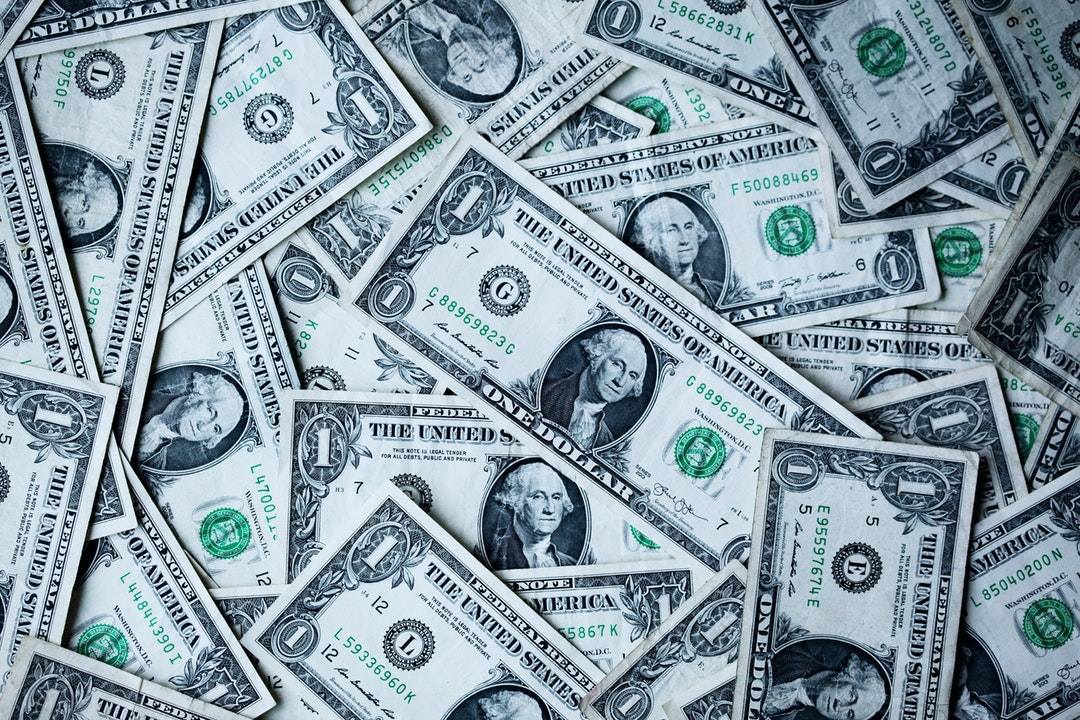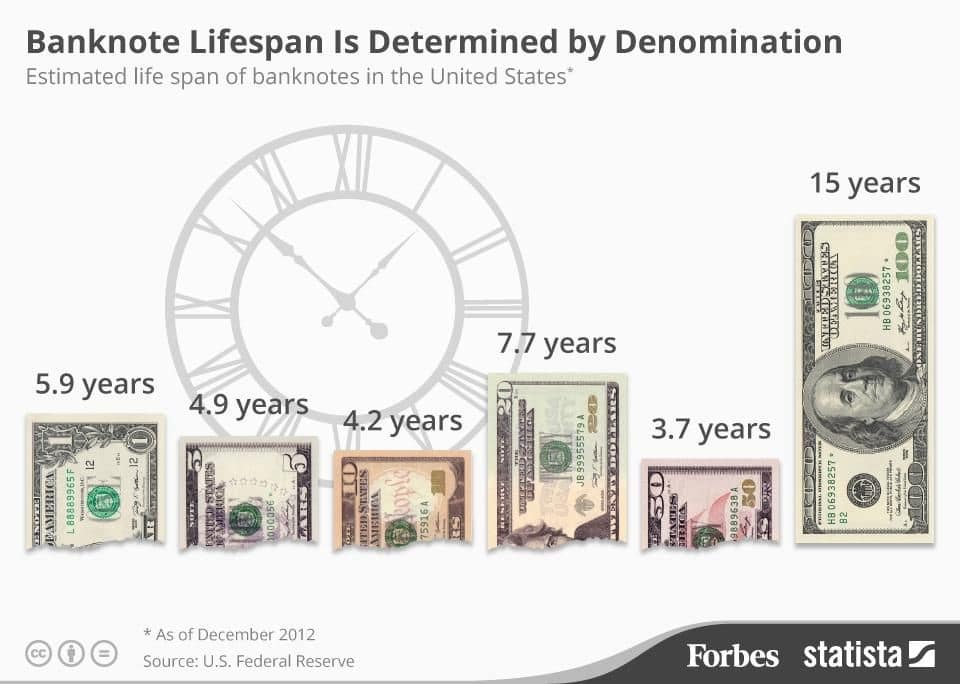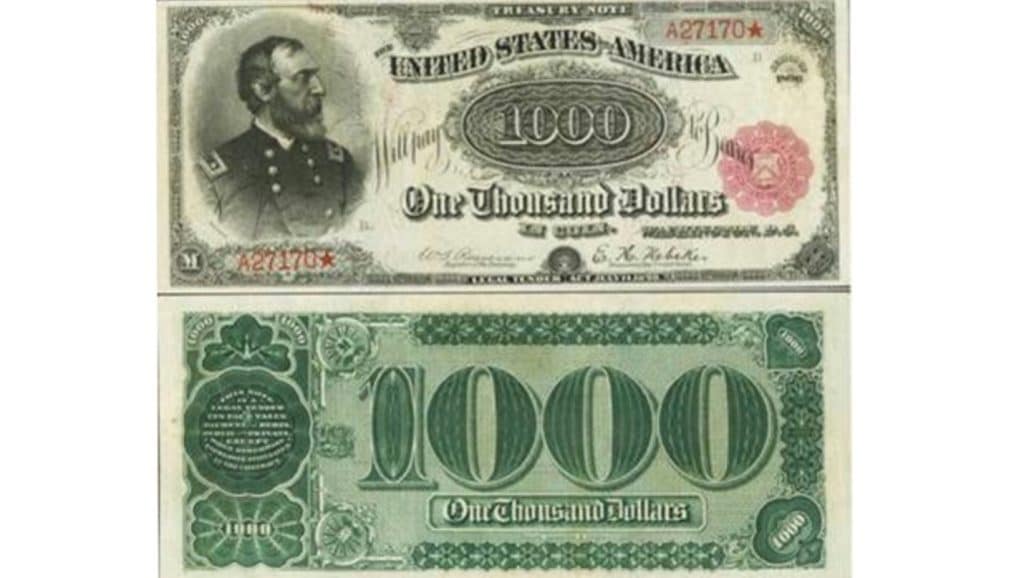Have you ever wondered about the money that you have in your pocket? How long does it last? How much of it is in circulation? What is the history of it? Money has been around for thousands of years as a form of currency and trade. Here are some interesting facts.
The Lifespan of Money
Let’s Look at Paper
Paper bills have varying lifespans based on their denomination. Larger bills aren’t passed as often, so it makes sense that they will be around longer. The U.S. Federal Reserve uses sophisticated scanning equipment to determine if a bill that comes into their possession is still fit for public use. Once it has deteriorated beyond the point of their standards it is destroyed. Here is a look at the average lifespan of U.S. paper currency according to Forbes.
What About Coins?
According to the U.S. Mint, the average lifespan of a coin is between 25 and 30 years. Once too worn to be considered usable the Mint will send them off to be destroyed and melted down to be made into new coins.
Some Really Old Money
The above are just averages. There are some extreme cases.
What is the oldest piece of paper currency known to exist? Paper currency was invented by the Ancient Chinese, and most of what is discovered during archeological digs are fragments or old brass molds. However, it was announced in the late 1980’s that 2 ancient Chinese paper notes dating to the year 1275 were discovered and are now being held in a museum. It is believed that these 2 notes are the oldest complete paper currency examples in existence.
As for coins: That honor goes to the Lydian Lion which predates ancient Greek coin making. These coins were currency in Ancient Lydia, which is today modern-day western Turkey. The actual age of these coins is debated, but it is believed that they were minted during the rule of King Alyattes who ruled Lydia c. 550 – 610 BCE.
How Much Money is Being Made?
The Bureau of Engraving and Printing produces 38 million notes a day with a face value of $541 million. Around 95% of these notes are replacing old notes that were taken out of circulation, so the money supply is not growing by $541 million a day, but still, that’s a lot of money rolling off the presses.
A Penny for Your Thoughts
The Mint produces pennies at a rate of 1040 per second. That comes out to 13 billion per year. In fact, over two thirds of all coins produced in a year are pennies. Here are a few facts about the pennies in your pocket:
- The penny was the first coin to be produced by the U.S. Mint. In March of 1793 the Mint distributed 11,178 of them.
- There have been 11 different designs on the penny throughout the years.
- The Lincoln Penny was first circulated in 1909, the 100th anniversary of his birth.
- Lincoln’s portrait faces to the right. All other portraits on coins are facing left.
- The penny is the first U.S. currency to include the phrase “In God We Trust.”
- A penny costs .93 cents to make
The $2 Bill
The famous $2 bill is always a conversation piece at a gathering if you happen to have one in your pocket. Here are some interesting facts about this note:
$2 Bills were first printed in 1862 along with the first printing of other paper money denominations but it didn’t catch on, because at the time most people made less than $15 a month making paper money less practical.
The $2 Bill earned a bad rap early on, as many nefarious practices were at the $2 price point. Politicians were often known for bribing voters with a $2 bill. A go with a prostitute was $2. And, $2 was a standard bet at the race track. The $2 bill quickly gained a reputation for bribery, infidelity, and gambling. Here are a few more facts:
- As inflation ramped up the value of the $1- and $2-dollar bills came closer together making the $2 Bill unnecessary, so the Government stopped its printing in 1966. It wasn’t until 1976 during America’s Bicentennial celebration that the note was reintroduced.
- Alexander Hamilton was originally featured as the portrait of the $2 Bill. Thomas Jefferson became the face of the bill in 1869.
- John Trumbull’s painting “Declaration of Independence” replaced the original picture of Thomas Jefferson’s home, Monticello on the reverse side of the bill in 1976.
- $2 Bills are the rarest of U.S. currency in active printing and circulation, making up less than 1% of the money supply.
- $2 Bills are sometimes used as tracers by some retailers. One will be placed in the cash register and the serial number will be recorded. In the event of a robbery the money can be tracked.
The Most Valuable Money
Certain coins and paper notes are sought after by collectors for various reasons. Here are the most valuable ones out there.
1890 Grand Watermelon Bill
This note is the rarest and most valuable of U.S. Currency notes. The name comes from the watermelon look of the zeros on the bill. One was sold at auction for over $3.6 million dollars.
1794 Flowing Hair Dollar
This coin was the first silver dollar coin stuck by the U.S Mint and was the first dollar coin standardized across the country. The original face value was $1, but this coin has an estimated value of $10 million dollars today.
Conclusion
The next time you have some change in your pocket or pay with something with some bills stop and think about the history of the currency that you are using. How long has that particular note or coin been around? How many hands has it passed through? Money as a form of currency has a rich history spanning back thousands of years. The proceeding was just a brief history of some of the more common and interesting parts of that history. There are countless more facts that you can learn. Just remember that your money a lot more history and significance than its face value.
Readers see also:
How Long is a Dollar Bill Around? The Lifespan of a One Dollar Bill
Six Currencies of the World and How Their Values Might Change
Understanding the basic concepts of Forex trading
Why Do We Value Worthless Paper As Money?

Based in the Pittsburgh, PA area, Brian holds full-time employment as a Warehouse Manager for an electronics firm. Brian enjoys wealth building, investing, gardening and the great outdoors. Brian holds a B.A. in Environmental Studies from the University of Pittsburgh and an MBA from Robert Morris University.















